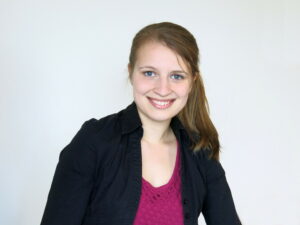Biography
Dr. Kerstin Göpfrich is leading the Max Planck Research Group Biophysical Engineering at the Max Planck Institute for Medical Research in Heidelberg, exploring de novo approaches to create synthetic cells from the bottom up. In particular, her work focuses on DNA nanotechnology as a tool to arrange components inside synthetic cells in space and time or to construct functional units from scratch. She studied physics and molecular medicine at the University of Erlangen.
As a Gates Fellow at the University of Cambridge, UK, she then worked in the group of Ulrich Keyser and received her PhD in Physics in 2017. Until September 2019, Kerstin was a Marie Skłodowska-Curie Fellow at the Max Planck Institute for Intelligent Systems in Stuttgart in the department of Prof. Joachim Spatz. In 2017, she founded www.ring-a-scientist.org to bring science into the classroom.
Education and positions held
- 2017-2019:
- Max Planck Institute for Intelligent Systems, Stuttgart, Germany, Marie Skłodowska-Curie Postdoctoral Fellow
- 2013-2017:
- University of Cambridge, United Kingdom, PhD student in Physics
- 2012-2013:
- University of Cambridge, United Kingdom, M.Phil. in Physics
- 2009-2012:
- University of Erlangen, Germany, B.Sc. in Physics and Molecular Medicine
Research Summary
What is life? and Could it be different? While questions like these have fascinated mankind for centuries, it is exciting that science begins to develop tools to approach them. Bottom-up synthetic biology conventionally isolates and subsequently recombines biomolecules from cells. Instead of copying life as we know it, our group tries to engineer cells featuring completely new ways of assembly, information propagation, and replication.
Towards this goal, we are combining biophysical tools, including DNA origami, microfluidics, lipid vesicles, and 3D printing with experimental methods, like confocal and high-speed microscopy, atomic force microscopy, cryo-electron microscopy, and computational approaches. In particular, we focus on DNA nanotechnology to construct functional mimics of cellular components.
Key publications
- K Göpfrich, MJ Urban, C Frey, I Platzman, JP Spatz, N Liu, Dynamic actuation of DNA-assembled plasmonic nanostructures in microfluidic cell-sized compartments, Nano Letters 20 (3), 1571-1577, 2020
- K Göpfrich, B Haller, O Staufer, Y Dreher, U Mersdorf, I Platzman, JP Spatz, One-pot assembly of complex giant unilamellar vesicle-based synthetic cells, ACS synthetic biology 8 (5), 937-947, 14, 2019
- K Göpfrich, I Platzman, JP Spatz, Mastering complexity: towards bottom-up construction of multifunctional eukaryotic synthetic cells, Trends in biotechnology 36 (9), 938-951, 74,2018
- K Göpfrich, CY Li, M Ricci, SP Bhamidimarri, J Yoo, … UF Keyser, Large-conductance transmembrane porin made from DNA origami, ACS Nano 10 (9), 8207-8214, 86, 2016
- K Göpfrich, CY Li, I Mames, SP Bhamidimarri, M Ricci, J Yoo, … UF Keyser, Ion channels made from a single membrane-spanning DNA duplex, Nano Letters 16 (7), 4665-4669, 59, 2016

